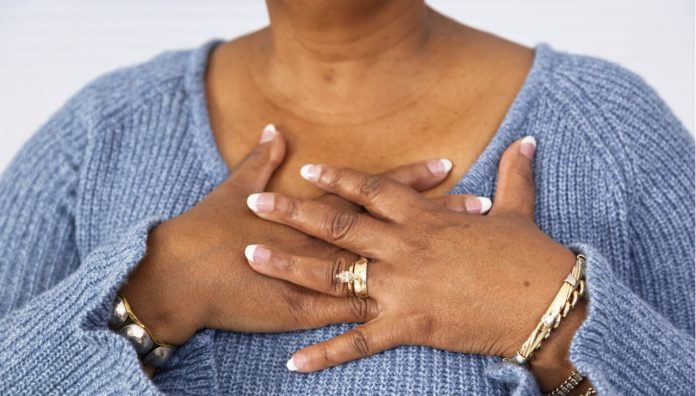Cardiovascular disease is the largest cause of death in Australian women and pharmacists can help them check their heart health and manage their risk factors.
Cardiovascular disease (CVD) has been confirmed as the number one killer of Australian women, according to the most recent figures released by the Australian Institute of Health and Welfare (AIHW).1
Often under-recognised and undertreated, early identification and management of heart disease in women is vital to address this alarming statistic.
Pharmacists are in an excellent position to advise women to have regular heart health and blood pressure checks. Women aged over 50, those who have had a cardiovascular event as well as younger women with complications (including those who are pregnant) should all be encouraged to have regular heart health checks.
The 2019 AIHW report, Cardiovascular disease in women—a snapshot of national statistics shows that more than half a million Australian women have CVD, which accounts for almost a third of all deaths among women. AIHW spokesperson, Miriam Lum On, pointed out at the release of the report in June, that CVD is the most deadly disease group for women.2
The report looked at common forms of CVD (coronary heart disease, stroke, heart failure and cardiomyopathy). It found CVD was the fifth largest cause of non-fatal disease burden for women, behind musculoskeletal conditions, mental and substance use disorders, respiratory diseases, and neurological conditions.1
In addition, Aboriginal and Torres Strait Islander women (6.9%) were almost twice as likely as non-indigenous women (3.8%) to have CVD.1
Cardiovascular disease is often seen as an issue predominantly affecting men. However, there is increasing recognition that aspects of its prevention, treatment and management are unique to women.2
Although the CVD burden has fallen substantially over recent decades, improvements are smaller for younger women. In fact, their rates of stroke and hospitalisation due to CVD overall have increased.2
CVD is a largely preventable and treatable group of conditions. Along with most chronic conditions, CVD risk factors include tobacco use, risky alcohol consumption, overweight and obesity, physical inactivity and high blood pressure.
What can pharmacists do to help identify heart disease in women and address CVD risk factors?
Dr Monique Watts, a cardiologist with a special interest in women’s heart disease at the Alfred Hospital’s Women’s Heart Clinic, says ‘chest pain should always be investigated, especially if it’s accompanied by shortness of breath or a reduction in exercise capacity.’
As a woman’s risk of heart disease increases after menopause, Dr Watts recommends a heart health check for all women over 50.
Increased risk should also be considered in younger women such as those with complications in their pregnancies. Dr Watts says ‘pregnancy is like a stress test for the cardiovascular system. Women who have experienced gestational diabetes, gestational hypertension, pre-eclampsia, pre-term delivery or delivered small for gestational age infants are at an increased risk for heart disease and at a younger age.’
Women postpartum have many reasons to go to the pharmacy but are often focused on their children and not themselves. Dr Watts says those who’ve had complicated pregnancies should be referred to their doctor for assessment and management of cardiovascular risk. With ready access to this group of women, pharmacists can help with referral and education.
It’s a common belief that women are better at looking after their health than men. But research shows that many women don’t. They often put the needs of others before themselves. They are less likely to attend cardiac rehabilitation, less likely to take their medication regularly, and are less likely to make the lifestyle changes necessary for good health.3
Pharmacists are in a prime position to encourage a healthy lifestyle to address CVD risk factors.
To promote heart health, Dr Watts says ‘pharmacists can play a positive role in raising awareness among women about heart disease by encouraging them to have a heart health check, and by facilitating a blood pressure check’.
‘Often women find popping into the pharmacy to have their blood pressure checked less confronting than going to the doctor,’ Dr Watts says.
‘Checking blood pressure sounds like a simple thing but a lot of women don’t have their blood pressure checked. This is an area where pharmacists can really make a difference.’
Chronic conditions, including CVD, are priorities for action in the National Women’s Health Strategy 2020–2030.1
For resources on women and heart disease go to: https://www.heartfoundation.org.au/your-heart/women-and-heart-disease/
References
- Australian Institute of Health and Welfare 2019. Cardiovascular disease in Australian women—a snapshot of national statistics. Cat. no. CDK 10. Canberra: AIHW.
- Cardiovascular disease affects half a million Aussie women. AIHW media release 18 June 2019.
- Women and heart disease. The Heart Foundation. At: https://www.heartfoundation.org.au/your-heart/women-and-heart-disease/.




 ‘We’re increasingly seeing incidents where alert fatigue has been identified as a contributing factor. It’s not that there wasn’t an alert in place, but that it was lost among the other alerts the clinician saw,’ Prof Baysari says.
‘We’re increasingly seeing incidents where alert fatigue has been identified as a contributing factor. It’s not that there wasn’t an alert in place, but that it was lost among the other alerts the clinician saw,’ Prof Baysari says.


 Beyond the arrhythmia, AF often signals broader pathological processes that impair cardiac function and reduce quality of life and life expectancy.5 Many of these conditions are closely linked to social determinants of health, disproportionately affecting populations with socioeconomic disadvantage. Effective AF management requires addressing both the arrhythmia and its underlying contributors.4
Beyond the arrhythmia, AF often signals broader pathological processes that impair cardiac function and reduce quality of life and life expectancy.5 Many of these conditions are closely linked to social determinants of health, disproportionately affecting populations with socioeconomic disadvantage. Effective AF management requires addressing both the arrhythmia and its underlying contributors.4  C – Comorbidity and risk factor management
C – Comorbidity and risk factor management Warfarin
Warfarin







